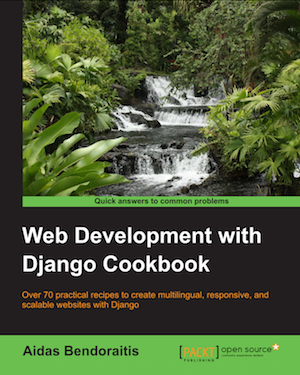In the early beginning of year 2014, the IT book publishing company "Packt Publishing" contacted me with an interesting offer: to share my Django experience in a form of a book. I thought it might be a good challenge for me and also value for the Django community, as I had been working with Django for 7 years or so, and during that time there was quite a lot of knowledge gathered and used practically. So for the next 9 months on late evenings and weekends I was adapting some of the most useful code snippets and describing them in the book. The great staff from the Packt Publishing helped me to structure the content, make everything clear and understandable, and get the grammar correct. Finally, the book was released and it's called "Web Development with Django Cookbook".
This book is written for intermediate or advanced Django web developers. When writing the book, my own purpose was not to fully cover every possible web development task, but rather to have enough useful bits of knowledge for those who seek information about web development with Django. The book was written in the format of recipes. There are over 70 recipes giving you instructions how to deal with different challenges of web development. The code mentioned in the book is optimized for Django 1.6, but most of it should also work with older Django versions as well as with Django 1.7.
The cookbook consists of 10 chapters:
- Getting started with Django 1.6. This chapter will guide you through the basic configuration which is necessary to start any Django project. It will cover topics like virtual environment, version control, and project settings.
- Database Structure. When you create a new app, the first thing to do is to define your models. In this chapter you will learn how to write reusable pieces of code to use in your models. You will learn how to deal with multilingual data in your database. Also you will be told how to manage database schema changes using South migrations.
- Forms and Views. To show your data or let one create it, you need views and forms. This chapter will show you some patterns for creating them.
- Templates and JavaScript. Information is presented to the user by rendered templates. In modern websites, JavaScript is a must for richer user experience. This chapter shows practical examples of using templates and JavaScript together.
- Custom Template Filters and Tags. The default Django template system is quite extensive, but there are more things to add for different cases. This chapter shows you how to create and use own template tags and filters.
- Model Administration. Django framework comes with a handy pre-build administration. This chapter shows how to extend the default administration with your own functionality.
- Django CMS. Django CMS is the most popular open source content management system made in Django. This chapter deals with best practices using Django CMS and extending it for your needs.
- Hierarchical Structures. When you need to create a tree-like structure in Django, django-mptt module comes to hand. This chapter shows you how to use it and how to set administration for hierarchical structures.
- Data Import and Export. Very often there are cases when you need to transfer data from and to different formats, retrieve it from and provide it to different sources. This chapter deals with management commands for data import and also APIs for data export.
- Bells and Whistles. There is more to Django. This chapter shows additional snippets and tricks useful in web development with Django. Also you will learn about deployment of Django projects.
Get a copy of this book at Packt Publishing and tell me what you think about it in the comments below. Which recipes did you find the most useful? What would you like to read more in this blog or another edition of the cookbook?

